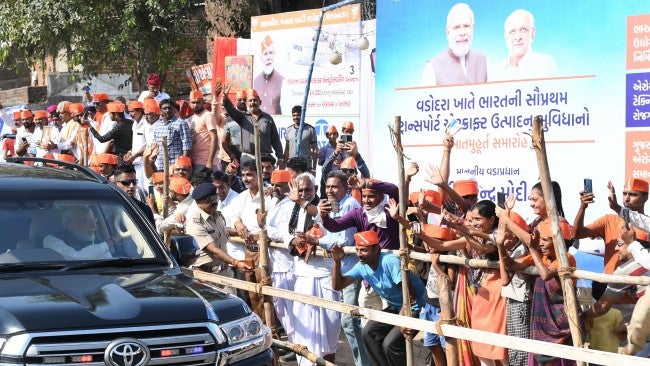Summary
The Bharatiya Janata Party’s (BJP) record victory in Gujarat was founded both on Prime Minister Narendra Modi’s popularity in the state and its party machinery. The Aam Aadmi Party (AAP) played a role in the scale of the BJP’s victory by eating into the Congress votes. The AAP’s role as spoiler for the Congress could well prove to be a recurrent feature in states that have traditionally seen bipolar contests.
The Bharatiya Janata Party (BJP) swept back to power in Gujarat, Prime Minister Narendra Modi’s home state, winning a record 156 out of 182 seats in the state Assembly. The BJP’s victory bettered the Congress’s record of winning 149 seats in 1985. While a BJP victory was anticipated, the scale of the win was not even predicted by exit poll results released on the day the polling ended. Not only did the BJP increase its seat tally from 99 in the 2017 Assembly election, but it also increased its vote share from 49 to 52.5 per cent.
The BJP largely owed its massive victory to Modi, a four-time chief minister of Gujarat from 2001 to 2014, who campaigned extensively in the state. The well-oiled party machinery and the welfare schemes implemented in the state too played their part in the victory. Since March 2022, Modi had made several trips to Gujarat and campaigned in over 100 assembly seats employing both election rallies and road shows. According to the Centre for the Study of Developing Societies-Lokniti post-election survey, over half the respondents said that Modi had fulfilled the people’s expectations. When asked whether they had voted for Modi in this election, half the respondents said they had. Indeed, one of the unusual aspects of the election was the high number of respondents who voted for the BJP with nearly half saying that they had made up their mind on who to vote for only 48 hours before polling. Again, this pointed to the success of the BJP’s electoral campaign spearheaded by Modi.
The BJP’s support also cut across caste and class. The party increased its vote share among the upper castes, Patidars, Other Backward Classes, Scheduled Castes and Scheduled Tribes. It also fared better among younger voters, those with more education and those in urban areas. However, the BJP’s vote share among Muslim voters fell from 27 per cent in 2017 to 14 per cent in 2022.
Beyond the BJP’s inherent strengths, the other major factor behind the scale of the BJP’s victory was the presence of the Aam Aadmi Party (AAP) for the first time in Gujarat. The AAP effectively split the opposition vote in a state that has traditionally seen only one opposition party and a bipolar contest. The Congress, which won 77 seats and 41 per cent of the vote share in 2017, could only win 17 seats with a vote share of 27 per cent. This had much to do with the AAP winning 13 per cent of the vote share, which primarily ate into the Congress vote, although it won only five seats. While the combined vote share of the Congress and the AAP was significantly lesser than the BJP’s overall vote share, in the Saurashtra region, their combined vote share was very similar to that of the BJP’s. This had an impact on the results in at least 54 seats and contributed to the BJP’s margin of victory.
Besides the presence of the AAP, the Congress ran a lacklustre campaign in Gujarat, with central leaders like Rahul Gandhi largely absent and busy with the party’s ‘Bharat Jodo Yatra’. There were also statements by senior Congress leaders taking part in the ‘yatra’(pilgrimage), that the party was not interested in only winning elections.
Beyond Gujarat, the AAP could prove to be a spoiler for the Congress in the foreseeable future in states where the competition has been traditionally bipolar. However, that did not happen in Himachal Pradesh where the results for the Assembly elections were announced the same day as that of Gujarat. In Himachal Pradesh, the Congress and the BJP had a near identical vote share of 43 per cent but the Congress won 45 seats to the BJP’s 25. The Congress was helped by the fact that the AAP, unlike in Gujarat, had a poor showing, getting only one per cent of the vote share and was unable to win a single seat. The presence of the BJP rebels in the electoral fray also helped the Congress.
While the BJP will be heartened with the results in Gujarat and argue that it was a dead heat, in terms of vote share, in Himachal Pradesh, the opposition will have plenty to ponder in the upcoming assembly polls in 2023 and the national election in 2024. If the opposition is united, it could pose a challenge to the BJP in several states. However, in instances where the AAP and the Congress are vying for the same votes, the BJP stands to benefit.
. . . . .
Dr Ronojoy Sen is a Senior Research Fellow and Research Lead (Politics, Society and Governance) at the Institute of South Asian Studies (ISAS), an autonomous research institute at the National University of Singapore. He can be contacted at isasrs@nus.edu.sg. The author bears full responsibility for the facts cited and opinions expressed in this paper.
Pic Credit: CMO Twitter Account
-
 More From :
More From :
-
 Tags :
Tags :
-
 Download PDF
Download PDF



